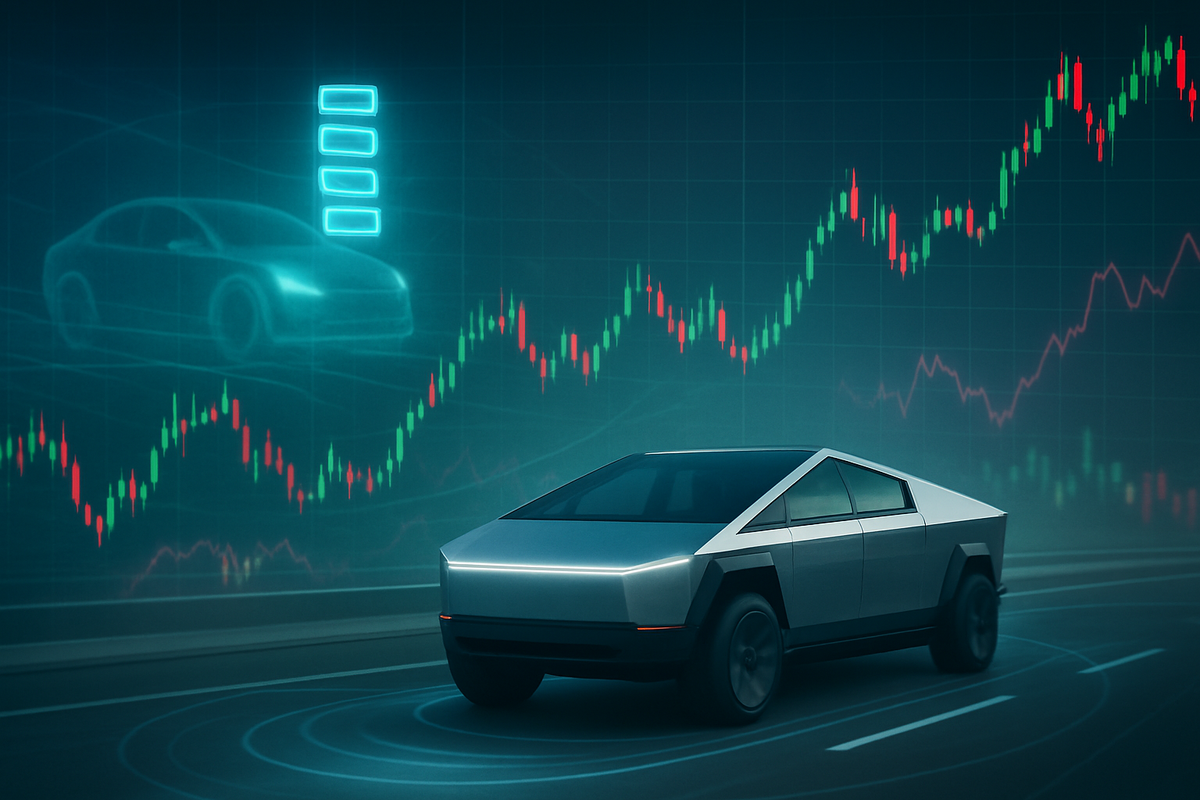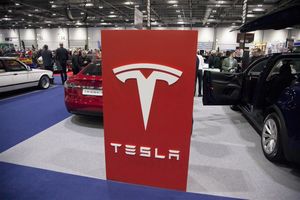
The financial markets have been on an exhilarating ride, closely tracking the every move of electric vehicle (EV) titan Tesla (NASDAQ: TSLA). From ambitious production ramps of its futuristic Cybertruck to the persistent pursuit of an affordable mass-market EV and the contentious evolution of its Full Self-Driving (FSD) technology, Tesla's announcements between late 2024 and mid-2025 have acted as powerful market catalysts, sending ripples through investor sentiment and stock futures. As of October 19, 2025, the company continues to stand at the epicenter of innovation and intense scrutiny, dictating trends not just within the automotive sector but across broader technological and financial landscapes.
This period has been characterized by a blend of challenging quarterly earnings, strategic product developments, and significant corporate governance discussions. Each announcement, whether a production milestone or a regulatory probe, has been met with a nuanced market reaction, reflecting the complex interplay of investor optimism, technological potential, and inherent risks. Understanding these dynamics is crucial for investors and industry observers alike, as Tesla's trajectory often serves as a bellwether for the future of electrification and autonomous mobility.
A Year of Pivotal Announcements and Volatile Reactions
The past year has been a whirlwind for Tesla, marked by a series of high-stakes announcements that have alternately bolstered and challenged investor confidence. The company navigated a complex landscape of production goals, technological advancements, and increasing regulatory oversight.
Beginning with Q4 2024 earnings, reported on January 29, 2025, Tesla missed Wall Street's revenue and EPS expectations, posting $25.71 billion in revenue against an expected $27.21 billion. The automotive segment saw an 8% year-over-year decline, primarily due to aggressive price cuts. The market initially reacted negatively, with the stock dropping 5% post-announcement and another 8% the following morning. However, a surprising recovery ensued, fueled by long-term optimism regarding Tesla's autonomous driving vision and a reaffirmed commitment to affordable vehicle production in the first half of 2025.
This pattern of financial misses tempered by strategic optimism continued into Q1 2025 earnings, reported on April 22, 2025. Total revenue declined 9% year-over-year to $19.3 billion, and automotive revenue dropped 20%. Despite these disappointing figures and the removal of its growth forecast due to "near-term headwinds," Tesla's stock remarkably rallied over 6% in after-hours trading. This resilience was attributed to insider confidence, strong sales in China, and the continued anticipation of FSD breakthroughs and the promised cheaper model.
By Q2 2025 earnings, reported on July 23, 2025, revenue slightly beat consensus at $22.496 billion, but automotive revenue again fell, by 16% year-over-year. Adjusted EPS matched predictions. The market reaction was muted, with a slight aftermarket decline, as investors scrutinized the company's performance amidst challenging market conditions and declining sales.
Beyond earnings, the Cybertruck production ramp-up at Gigafactory Texas has been a key focus. Throughout late 2024 and mid-2025, Tesla steadily increased output, reaching 1,300 units per week by June 2024 and aiming for 2,500 by year-end. The company declared Cybertruck production was on track for profitability by the end of 2024, shifting focus from Foundation Series to non-Foundation units. This increased production, despite earlier challenges, was largely viewed positively, as the unique vehicle is poised to disrupt the electric pickup market.
The long-awaited affordable EV, often dubbed "Model 2" or "Redwood," also saw significant developments. Rumors solidified into partial confirmations in early 2025, with Tesla indicating plans for "new models" by early 2025 utilizing existing platforms to accelerate their introduction. Reports suggested a potential price point under $15,000-$25,000 after incentives, with mass production possibly beginning in June 2025, targeting 500,000 units. This prospect of a mass-market EV sent Tesla shares soaring in April 2024 and continues to fuel optimism about expanding the company's total addressable market.
Full Self-Driving (FSD) technology remained a double-edged sword. While advancements and the anticipation of FSD V14.2 release contributed to a stock rally in early October 2025, signaling new revenue streams, the technology faced intense scrutiny. In October 2025, the U.S. National Highway Traffic Safety Administration (NHTSA) launched a major inquiry into 2.88 million Tesla vehicles equipped with FSD, following over 50 reported incidents. This ongoing investigation introduces significant uncertainty and could impact investor confidence.
Further technological strides were announced in late August 2025, with the unveiling of a new battery technology featuring aluminum-ion advancements. Promising up to 745 miles of range and 15-minute charging, with production vehicle integration aimed for within 18 to 24 months, this news initially caused a nearly 5% stock surge. However, the enthusiasm was somewhat tempered by the mixed Q2 2025 earnings report.
Finally, shareholder meetings in October 2025 brought governance issues to the forefront. Proxy advisory firm Institutional Shareholder Services (ISS) recommended against Elon Musk's proposed $1 trillion compensation plan, introducing volatility. Simultaneously, Tesla announced plans for another stock split in 2025, a move designed to make shares more accessible, which immediately lifted the stock price. These developments highlight the ongoing tension between ambitious corporate leadership and investor oversight.
Shifting Fortunes: Winners and Losers in the Wake of Tesla's Moves
Tesla's strategic announcements and market performance inevitably create ripple effects, elevating some players while challenging others across the automotive and technology landscapes. The pursuit of an affordable EV, the ramp-up of Cybertruck production, and advancements in FSD technology are reshaping competitive dynamics.
Potential Winners:
- Tesla (NASDAQ: TSLA) itself, if its strategies bear fruit: Should the "Model 2" achieve mass-market success, it could unlock unprecedented sales volumes and solidify Tesla's dominance in the global EV market. Similarly, if FSD technology matures into a reliable and widely adopted solution, it could generate significant recurring revenue through subscriptions and potentially revolutionize transportation, placing Tesla at the forefront of the autonomous revolution. The successful scaling of Cybertruck production and its profitability also directly boost Tesla's bottom line.
- Battery Technology Suppliers: Companies involved in the supply chain for advanced battery materials, particularly those aligned with Tesla's new aluminum-ion battery architecture, stand to benefit. Firms specializing in lithium, nickel, cobalt, and especially aluminum processing for EV batteries could see increased demand and investment. While specific partners weren't named in the research, any company that can meet Tesla's stringent demands for next-generation battery components would be a clear winner.
- Charging Infrastructure Providers: As Tesla expands its vehicle fleet, especially with more affordable options, the demand for robust charging infrastructure will grow. While Tesla has its Supercharger network, third-party charging companies (e.g., ChargePoint (NYSE: CHPT), EVgo (NASDAQ: EVGO)) that offer compatible solutions could see increased utilization and expansion opportunities, particularly as Tesla opens its network to other EVs.
- AI and Software Development Firms: Companies specializing in AI, machine learning, and sensor technology that could potentially integrate with or enhance autonomous driving systems, even if not directly partnered with Tesla, could see increased investment and demand as the FSD race intensifies.
Potential Losers:
- Traditional Automakers (Legacy OEMs): Companies like General Motors (NYSE: GM), Ford (NYSE: F), Volkswagen (ETR: VOW3), and Toyota (NYSE: TM) face immense pressure. Tesla's aggressive pricing strategy for its "Model 2" could severely undercut their nascent or struggling EV offerings, particularly in the crucial mass-market segment. Their slower transition to EVs, reliance on internal combustion engine (ICE) profits, and often higher production costs put them at a disadvantage. The success of Cybertruck also pressures electric pickup competitors like Ford's F-150 Lightning and Rivian's (NASDAQ: RIVN) R1T.
- Newer EV Startups: Smaller, less established EV manufacturers such as Rivian (NASDAQ: RIVN), Lucid Group (NASDAQ: LCID), Nio (NYSE: NIO), and Xpeng (NYSE: XPEV) face an existential threat. Tesla's ability to scale production, reduce costs, and innovate rapidly makes it incredibly difficult for these companies to compete on price, technology, or market share, especially if Tesla launches a truly affordable vehicle. Their niche markets could shrink, and investor confidence might shift towards the dominant player.
- Ride-Sharing and Logistics Companies (if FSD fully matures): In the very long term, if Tesla's FSD achieves full autonomy and leads to widespread robotaxi networks, it could disrupt traditional ride-sharing services like Uber (NYSE: UBER) and Lyft (NASDAQ: LYFT) by offering potentially cheaper, more efficient, and owner-operated autonomous transport. This is a distant prospect, but the potential for disruption is significant.
- Fossil Fuel Industry: Continued growth in EV adoption, spurred by more affordable models from Tesla, further accelerates the decline in demand for gasoline and diesel, impacting oil and gas companies (e.g., ExxonMobil (NYSE: XOM), Chevron (NYSE: CVX)) and related infrastructure.
The impact on these companies is not just theoretical; it translates into stock price volatility, strategic re-evaluations, and intensified R&D efforts. Competitors are forced to accelerate their EV development, rationalize their pricing, and potentially form new alliances to counter Tesla's aggressive market maneuvers.
Wider Significance: Reshaping Industries and Regulatory Landscapes
Tesla's recent announcements are not isolated events; they are seismic shifts that resonate across multiple industries, influencing broader trends, challenging regulatory frameworks, and drawing parallels to historical technological disruptions. The company's actions serve as a potent indicator of the future trajectory for mobility, energy, and artificial intelligence.
Broader Industry Trends: Tesla's push for an affordable EV reinforces the accelerating global shift towards electric vehicles, making them accessible to a much larger consumer base. This intensifies the "EV price war," forcing all automakers to prioritize cost-efficiency, scale, and supply chain optimization. The Cybertruck's unique design and production ramp signal a maturing electric pickup market, pushing traditional truck manufacturers to innovate beyond conventional designs. Furthermore, Tesla's battery technology advancements underscore the critical role of material science and energy density in extending range and reducing charging times, driving further R&D across the battery industry. The ongoing FSD developments highlight the convergence of automotive and AI, establishing autonomous driving as a central pillar of future transportation and pushing the boundaries of what is technologically possible.
Ripple Effects on Competitors and Partners: The competitive pressure on legacy automakers and newer EV startups is immense. To survive, competitors must either differentiate through luxury, specific niches, or accelerate their own mass-market EV development, often at significant financial cost. This could lead to industry consolidation, strategic partnerships (e.g., joint ventures for battery production or charging networks), or even the demise of less agile players. Suppliers to Tesla, particularly those involved in battery components, advanced sensors, and AI processors, stand to gain significantly from increased production volumes. Conversely, suppliers tied to traditional ICE vehicles face declining demand and the imperative to pivot their businesses towards EV components.
Regulatory and Policy Implications: The scrutiny surrounding Tesla's FSD technology by the NHTSA is a critical development. It highlights the urgent need for comprehensive regulatory frameworks for autonomous driving, balancing innovation with public safety. The outcome of such investigations will likely set precedents for how self-driving systems are tested, deployed, and monitored globally. Governments worldwide are grappling with liability issues, ethical considerations, and data privacy concerns related to autonomous vehicles. Furthermore, Tesla's aggressive pricing and potential market dominance could attract antitrust attention, especially if its affordable EV significantly stifles competition. Policy decisions regarding EV incentives, charging infrastructure standards, and battery recycling will also be influenced by Tesla's market leadership.
Historical Precedents and Comparisons: Tesla's current trajectory echoes historical moments of technological disruption. Its impact on the automotive industry can be compared to Henry Ford's introduction of the Model T, which democratized car ownership and revolutionized manufacturing. Similarly, its disruption of traditional energy models with its battery and solar divisions parallels the shift from coal to oil. In the realm of software and AI, Tesla's FSD ambitions evoke comparisons to early internet pioneers or the rise of mobile computing, where a single company's innovation fundamentally reshaped an entire sector. The blend of visionary leadership, technological prowess, and intense market speculation also draws parallels to tech giants during the dot-com boom, emphasizing both the immense potential and inherent risks of such transformative companies.
The Road Ahead: Navigating Future Possibilities and Challenges
Tesla's journey through late 2024 and mid-2025 has set the stage for a future brimming with both immense opportunities and formidable challenges. The coming months and years will be pivotal in determining not only Tesla's long-term market position but also the broader direction of the electric vehicle and autonomous driving industries.
Short-term Possibilities and Challenges: In the immediate future, market attention will remain acutely focused on the successful launch and ramp-up of the "Model 2" (or affordable EV). Any delays or production bottlenecks could significantly dampen investor enthusiasm, while a smooth, high-volume rollout would be a powerful catalyst. The outcome of the NHTSA's FSD inquiry is another critical short-term factor; a negative ruling could severely impact FSD's deployment and investor confidence, whereas a favorable resolution could accelerate its adoption. Furthermore, the shareholder vote on Elon Musk's compensation plan in October 2025 will be closely watched for its implications on corporate governance and investor relations. Tesla must also navigate ongoing geopolitical tensions and supply chain vulnerabilities that continue to affect the automotive sector.
Long-term Strategic Pivots and Adaptations: Long-term, Tesla's strategic pivots will likely center on cementing its lead in battery technology and autonomous driving. The introduction of aluminum-ion batteries, if successfully integrated into production vehicles, could provide a significant competitive advantage in range and charging speed. The company's ability to monetize FSD through subscriptions and potentially robotaxi services will be key to unlocking new, high-margin revenue streams. For competitors, the imperative is to adapt rapidly: invest heavily in their own EV platforms, secure battery supply chains, and explore strategic partnerships to share R&D costs and market risks. Traditional automakers may need to consider more radical restructuring to shed legacy costs and accelerate their transition to software-defined vehicles.
Market Opportunities and Challenges: The expansion into the affordable EV segment presents a massive market opportunity for Tesla, potentially tapping into billions of new consumers globally. This also creates opportunities for companies in the charging infrastructure space, as a larger EV fleet necessitates more charging points. The ongoing development of FSD opens up new avenues in logistics, urban planning, and personalized mobility services. However, challenges include intensifying competition from Chinese EV manufacturers (e.g., BYD (HKG: 1211), Nio (NYSE: NIO)) who are rapidly gaining ground in technology and cost-efficiency. Regulatory hurdles, particularly concerning autonomous driving and data privacy, will remain a significant challenge for all players in the sector. The volatility of raw material prices for batteries and the global economic climate will also continue to influence market dynamics.
Potential Scenarios and Outcomes:
- Dominance Scenario: Tesla successfully launches the affordable EV, FSD achieves widespread regulatory approval and adoption, and its battery technology provides a decisive advantage. This leads to sustained market leadership, exponential growth, and potentially a re-rating of the company as a tech giant rather than just an automaker.
- Competitive Equilibrium Scenario: Tesla maintains a strong position but faces robust competition from legacy automakers and other EV startups who successfully adapt and innovate. The market becomes more fragmented, with different players dominating specific segments or geographies. FSD develops more slowly or faces significant regulatory constraints, limiting its immediate revenue potential.
- Stagnation/Decline Scenario: Production issues plague the affordable EV, FSD faces insurmountable regulatory or technological hurdles, and aggressive competition erodes market share. Tesla's stock could face sustained pressure, and its influence on the broader market might wane.
A Bellwether for the Future: Concluding Thoughts on Tesla's Impact
The period from late 2024 to mid-2025 has underscored Tesla's (NASDAQ: TSLA) enduring role as a primary market mover and a bellwether for the future of the automotive and technology sectors. Despite facing a mixed bag of financial results and intensified regulatory scrutiny, the company's strategic initiatives—particularly the pursuit of an affordable mass-market EV, the relentless ramp-up of Cybertruck production, and the ambitious development of Full Self-Driving technology—continue to capture global attention and shape investor sentiment.
The key takeaway from this dynamic period is Tesla's unparalleled ability to drive innovation and disrupt established norms, even in the face of significant challenges. Its announcements, whether related to earnings, new products, or technological breakthroughs, have consistently triggered notable market reactions, often defying conventional expectations. This resilience is rooted in a strong brand, a loyal customer base, and a clear long-term vision that many investors continue to buy into, despite short-term volatility.
Moving forward, the market will assess Tesla's trajectory through several critical lenses. The successful execution of the "Model 2" launch and its subsequent production scale will be paramount, as this vehicle is poised to unlock vast new consumer segments. The resolution of the NHTSA's FSD inquiry and the continued evolution of its autonomous capabilities will dictate the pace at which Tesla can truly revolutionize transportation and realize new revenue streams. Furthermore, the company's ability to manage its supply chain, control costs, and navigate an increasingly competitive global EV landscape will be crucial.
Investors should watch for tangible progress on these fronts in the coming months. Key indicators will include production targets for the affordable EV, updates on FSD regulatory approvals and wider deployment, and the financial performance of both the automotive and energy divisions. The ongoing saga of Elon Musk's compensation and broader corporate governance issues will also remain a factor influencing institutional investor confidence. Ultimately, Tesla's journey serves as a powerful reminder that in the rapidly evolving world of technology and finance, innovation, execution, and adaptability are the true drivers of lasting market impact.
This content is intended for informational purposes only and is not financial advice






